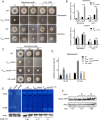Molecular Characterization and the Essential Biological Function of the Metal Chaperone Protein MtmA in Aspergillus fumigatus
- PMID: 35435716
- PMCID: PMC9088359
- DOI: 10.1128/aem.00182-22
Molecular Characterization and the Essential Biological Function of the Metal Chaperone Protein MtmA in Aspergillus fumigatus
Abstract
The detoxification system of reactive oxygen species (ROS) plays critical roles in the survival and virulence of fungal pathogens in infected hosts, while superoxide dismutase (SOD) is the primary ROS scavenger. In the model yeast Saccharomyces cerevisiae, the metal chaperone protein Mtm1 is required for mitochondrial Sod2 activation and responses to oxidative stress. However, the function of the S. cerevisiae Mtm1 homolog in the human fungal pathogen Aspergillus fumigatus has not yet been clarified. In this study, we found that mitochondria-localized MtmA in A. fumigatus, a putative homolog of yeast Mtm1, not only has a similar function to Mtm1 in responding to oxidative stress resistance by affecting SodB (MnSOD) activity but is also essential for hyphal growth such that repressed expression of MtmA results in severe growth defects in A. fumigatus. In addition, the chelation of Zn2+ can obviously rescue growth defects caused by repression of MtmA, suggesting that MtmA may be involved in hyphal growth by affecting cellular Zn2+ detoxification. Moreover, MtmA contains four Mito-carr domains, whereas only the first Mito-carr domain is required for the function of MtmA. Therefore, the findings in this study suggest that MtmA in A. fumigatus has an important and unique function that is different from that in yeast. IMPORTANCE Knowledge of the key factors required for the viability of pathogenic fungi can help to explore new antifungal drugs. Here, we demonstrate that MtmA is involved in responding to oxidative stress by activating mitochondrial SodB activity. MtmA, especially for the first Mito-carr domain, is essential for colony growth by regulating cellular Zn2+ equilibrium and responses to oxidative stress in A. fumigatus. This is the first report of the vital and unique role of the MtmA protein in pathogenic fungi, indicating that it might be a potential antifungal drug target.
Keywords: Aspergillus fumigatus; ROS; oxidative stress; superoxide dismutase.
Conflict of interest statement
The authors declare no conflict of interest.
Figures







References
Publication types
MeSH terms
Substances
LinkOut - more resources
Full Text Sources
Molecular Biology Databases

